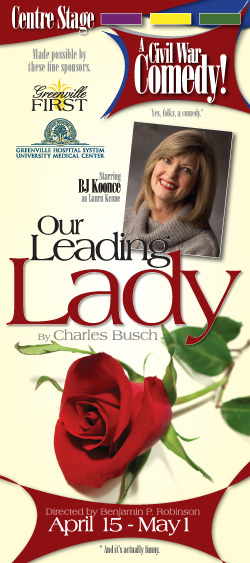The path of least correctness

At the top of the season, the best marketing angle for Charles Busch’s Our Leading Lady seemed obvious. The play is about the company of actors who were performing at Ford’s Theatre on the night Lincoln was shot and the star of the show – the eponymous leading lady – is Laura Keene, to be played in our production by local luminary BJ Koonce. So I had her photographed from above, costumed in shades of deep red, surrounded by deeper shades of red, reaching up to the camera with a come-hither look in her eyes. That image, combined with the slogan “The last woman Lincoln saw alive,” I hoped would convey a sense of mystery and dangerous sexuality. Who is this femme fatale? Did she kill Lincoln? Was she Lincoln’s lover?
But two months out from opening night, it dawned on us that we were “playing against type.” Our Leady Lady is a comedy. Granted, it’s a comedy that takes place in the context of Lincoln’s assassination, but it isn’t about that assassination. Our previous decision to emphasize the 35% drama/intrigue component of the show had been informed by our belief that it would be too difficult to convince the general public that we’d found something to laugh about in the still-bleeding tissue of the deepest wound ever inflicted on the national conscience … assassination, slavery, 620,000 dead. Holy cow.
But forget all that.
Some say that Busch wrote the show as a drag act for himself. A drag act. A drag act. And when you get right down to it, a comedy set in Ford’s Theater immediately before, during and after John Wilkes Booth assassinated Abraham Lincoln is marketing gold. It just is.
So we’ve decided to pursue the path of least political correctness on the assumption that anybody who finds offense with what we’re doing is looking for a fight and such people will find what they’re looking for regardless of what’s there to see.